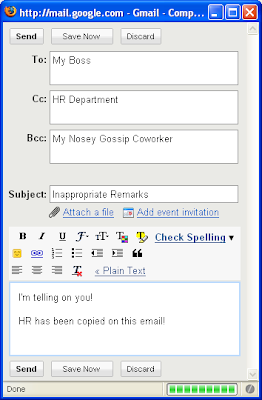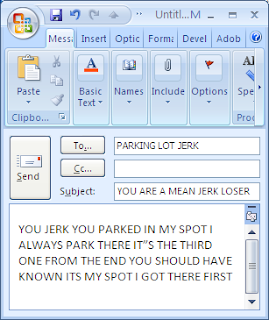
Lesson 4: The difference between CC and BCC
“CC” stands for carbon copy and “BCC” stands for blind carbon copy. What does this mean? I have no idea, people haven’t used carbon paper since Martin Van Buren was president and cigarettes didn’t cause cancer. All you really need to know is that they are the same, except for the “Blind” part which means that people on that list don’t see the email addresses of other people on that list.
The real trick is learning the proper time to show a list of all the recipients of an email, and when to keep it a secret. This skill is critical in both your personal and professional life; if you’ve ever been on somebody’s obnoxious joke list, you’ve probably already been a victim of this mistake.
As an aside, weekly joke lists absolutely suck if they are unsolicited. If you send one out, most people are too afraid of hurting your feelings to tell you to knock it off. Your stupid little “Recipe of the week” or “Cleaning Tip” is not appreciated if it is unsolicited. I don’t care how cute you think that picture of a cat is, how amazing the latest Nostradamus scam seems, or what the best way to clean a knob happens to be this week. These are just another form of chain-letter-junk-spam that annoys people.
Here’s an idea: Try not sending something next week; if you don’t get any emails asking something to the effect of “Why didn’t you send out a joke?” it’s a pretty good indication that nobody cares and that you should stop.
It’s time to step down from my soap box and see why that seeming digression was relevant. Since most of those lists copy everybody in the CC, if anybody hits “Reply to All” then everybody gets spammed. A snowball effect occurs as people get more and more annoyed. Eventually it always degenerates into swarms of messages containing a variant of “Stop sending &@#$&*$ emails!”
So what’s the rule here? If you have an announcement, newsletter, or joke that might be of interest to people who have no need to communicate with each other use BCC. Use CC when you are involved in a discussion with multiple people who are all interested, or when you explicitly want other people to be aware of who else is reading the email.
Think about it this way: the CC line is included in the email, and in forwards. You are basically including your mailing list in the email and allowing people to use it for whatever reason they choose. This doesn’t only correspond to the original email either, if it’s forwarded all those people’s names and addresses are forwarded too. You might end up on joke lists all over the country! Bad things like this can happen:
- We once used our landlord’s mailing list to coordinate and file official complaints about him. If he had used BCC we wouldn’t have known who all his tenants were. If you’re a slumlord, make sure you keep your serfs ignorant.
- In college somebody at the registrar’s office CC’ed the entire undergraduate class on a snow emergency notice. Whenever anybody got a virus after that it automatically got sent to everybody on campus. Even worse, people kept using it to solicit for plays, new websites, or ponzi schemes. I got more ads for Viagra than Sean Connery and I could practically paper my walls with Chinese penny stocks that “r about 2 exp!ode in pr1ce.”
I’m not sure why, but most email clients prioritize CC and make BCC hard to find, or disabled by default. It might take a little hunting around, some phone calls to India, or bothering that computer science nerd cousin, but eventually you’ll find it. Make good use of it.
Bonus Advanced Lesson
Let’s look at the following scenario. You’re sitting at work, minding your own business when your boss comes over and comments, “Hey, your butt looks awesome today!” While this would probably make your day, it’s obviously inappropriate. Consult the following chart to determine whether you should BCC, CC or email your boss directly:





